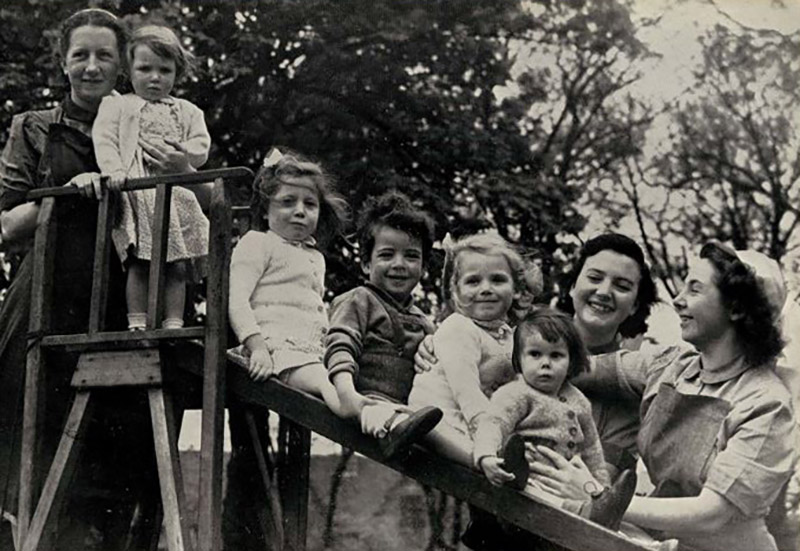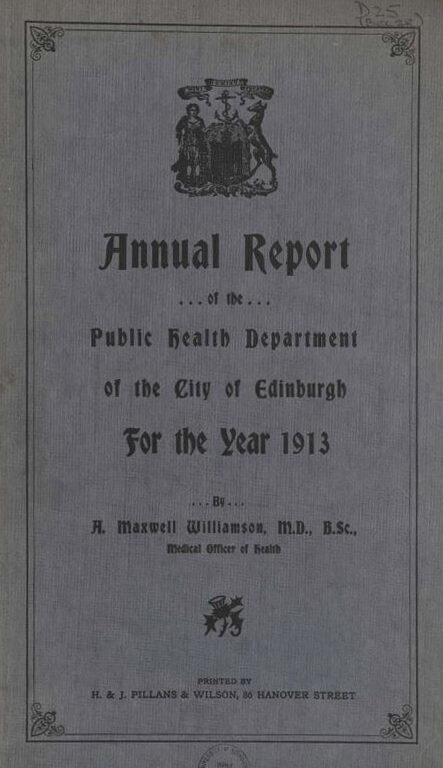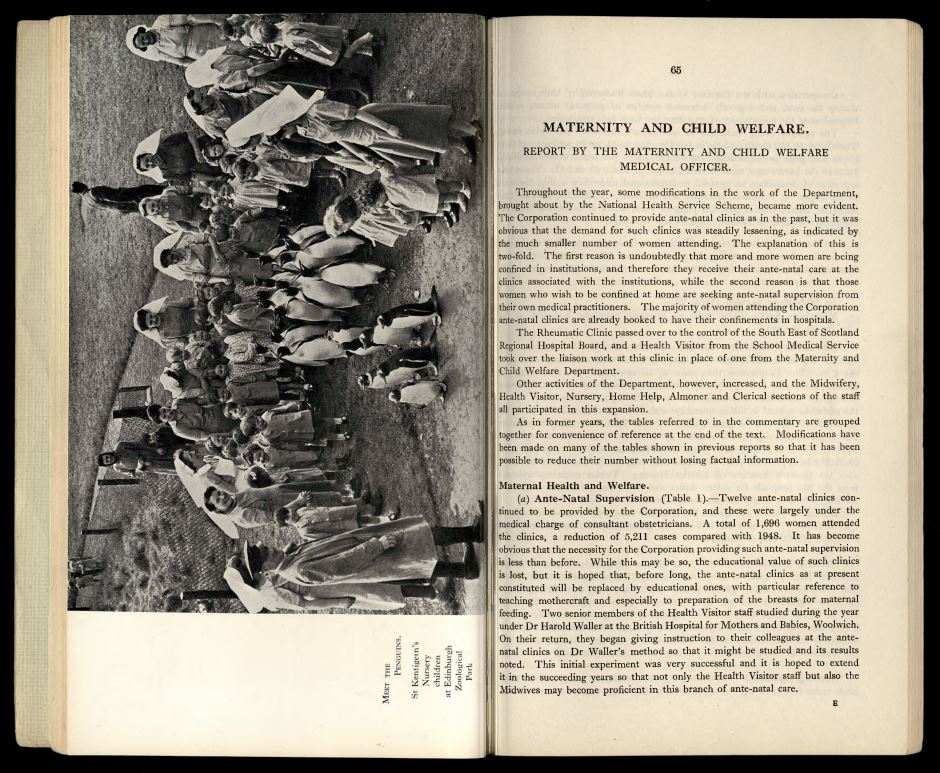
Over the last few months, our team has been working on digitising the Lothian Health Service Archive’s collection of Annual Public Health Reports for the City of Edinburgh. Comprising of 74 bound volumes of reports recording the public health of Edinburgh’s residents from 1865 to 1973, these documents are an absolute goldmine of information just waiting to be utilised by academics and researchers, covering everything from birth, death and disease rates to specific aspects of public health that were overseen by the City authorities, like infectious diseases or sanitation.
Building off the pioneering work of the City’s first Medical Officer of Health, Henry Duncan Littlejohn (1826-1914), these reports provide a fascinating series of snapshots of Edinburgh’s health spanning over a century (to read more about Henry Duncan Littlejohn’s work, you can find the LHSA’s blog here). Over the years, these reports have been used for a wide variety of research purposes, including by staff at the LHSA itself to find out more about the health services that were available for the residents of Edinburgh during this period. In their current bound format however, these reports are only available in a physical format, and this untapped potential is one of the key reasons we have been asked to digitise this part of the collection.

In general, all the volumes of this collection were in very good condition, although they did vary dramatically in size between smaller notebook-sized reports to much larger A3 volumes. As a result, we opted to scan them using our Bookeye 4 scanner which can safely scan most bound volumes up to A3. Alongside this, we also used our ABBYY processing software to convert our scans of the LHSA Annual Public Health Reports into pdfs that were OCR (optical character recognition) searchable. This way, instead of having to comb through the whole document, researchers will now be able to use keyword specific searching on the scans to find the information they’re looking for within the printed text of the original.
One of the most interesting aspects we found while digitising the reports (we’re always curious about the materials we’re scanning!) was getting to see the first mentions of the, at the time, brand new National Health Service coming into action. The NHS began on 5th July 1948, in the wake of the Second World War: “free for all at the point of delivery”. Scotland did already have its own version of a state funded health programme, the Highlands and Islands Medical Service (HIMS), which had been running for 35 years at this point. In general though, the poorest in society still faced barriers to accessing healthcare and assistance at hospitals was via charity, not a right. Its success however However the success of HIMS still helped influence public opinion in favour of the NHS, and now healthcare would truly be free for all.
The following excerpts from the yearly overviews covering 1948 – 1950 in particular give us a fascinating view into those early years of a service that we today take so for granted.
A Significant Year.
For several reasons the year 1948 will stand out significantly in the history of public health. In Scotland, it marked the beginning of the National Health Service as from 5th July, when the functions of local authorities were lessened by the transfer of hospitals to regional boards and enlarged by the introduction of new services and the extension of some of the- existing ones. The changes had been the subject of discussion and negotiation for more than two years, and in Edinburgh the actual transition took place smoothly and with no disturbance to hospital routine or to the local authority’s remaining services. (p.3)National Health Service.
A milestone in local government was reached on 5th July 1948 by the introduction of the National Health Service. Local authorities were relieved of hospital administration and had placed on them the duty of instituting entirely new services and the expansion of some services already existing. They also remained responsible for the various duties relating to the control of infectious diseases and those duties falling to the Sanitary and Veterinary Departments. Similarly, the School Health Service was unaltered by the National Health Service Act and remained under the administrative control of the Medical Officer of Health. (p.4)
National Health Service.
The National Health Service which came into being on 5th July, 1948, is still in the settling down process. Much of its novelty has worn off and the early rush for new services is subsiding. It is doubtful whether the man in the street could confess to a full understanding of the administrative machine and what he can obtain from it. Broadly his impression probably is that a fairly costly stamp goes on to his card each week and that, when required, he receives in return medical advice and medicines ; dental, optical and hearing aids and hospital treatment. These services are procured through the administrative arrangements of the Local Executive Council and the Regional Hospital Board. In addition, maternity, sickness, accident, unemployment, retirement and death benefits are obtained through the Ministry of National Insurance. (p.4)
National Health Service.
After two and a half years, the functions of the various administrative bodies connected with the National Health Service have become better understood, and the relative absence of friction or complaint may be taken as an indication that, broadly, the Service in Edinburgh is overcoming its teething troubles.
Reading these reports, you really get a first-hand insight into how the Lothian area dealt with such monumental changes, and which services were initially focused on in particular. For instance, this yearly overview from the 1950 Public Health Annual Report indicates that a major benefit of the NHS in the early years was an increase in home nursing, and in health visitors attending to mothers and young children in the community, no doubt contributing to the post-war decrease in mortality rates before, during, and after childbirth.
Care of Mothers and Young Children.
The state of health among the mothers and young children of Edinburgh continues to be very satisfactory. This is borne out by the extremely low maternal and infant mortality rates recorded during the past two years. If one were asked how these things continue to be possible in the face of present-day austerities in food, clothing, and housing accommodation, a brief answer might be that health visiting and intelligence in mothers go far to prevent ill-health and to maintain physical and mental stability. Health Visitors and enlightened mothers are, of course, complementary. There is nothing more potent than the friendly word of advice given by a skilled understanding person in the mother’s own home. Forty-one Health Visitors and three probationer Health Visitors engaged in this work made the record number of 92,939 visits during the year. (p.5)
“No part of the National Health Service is more highly valued than that of home nursing. In Edinburgh the work is done unobtrusively and efficiently by the Queen’s Institute of District Nursing and expressions of gratitude for the skilled attention received come from all sections of the community. It is a rather staggering fact that in Edinburgh nearly a quarter of a million visits are made to patients in their own homes by the Queen’s Nurses in the course of a year.” (p.7)

These reports really highlight the sheer breadth of public health issues that were dealt with by the City before the introduction of universal healthcare and provide a unique view of the impact that the introduction of the NHS had directly on the lives of Edinburgh’s residents, something that we often forget about nowadays having benefitted from it for almost a quarter of a century.
It’s been wonderful to see these snapshots of the lives and health of Edinburgh’s residents while digitising this part of the LHSA collection and we’re happy to announce that 64 out of the total 74 reports are now fully digitised and available online on our OpenBooks repository that can be accessed here! Watch this space for any progress updates, and don’t hesitate to let us know if you use any of these reports for research, we would love to hear what you are working on!
By Gaby Cortes (Digitisation Operator) & Charlotte Swindell (Digitisation Operator)
Sources:
- https://webarchive.nrscotland.gov.uk/20230324104912/http://www.ournhsscotland.com/history/birth-nhsscotland
- http://lhsa.blogspot.com/2015/10/towards-healthy-city.html
Be First to Comment